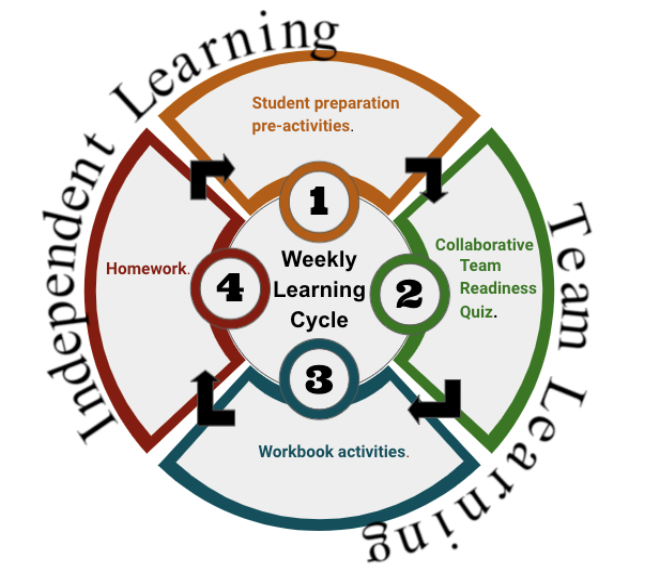Introduction
Team-based learning (TBL) is a structured, active-learning approach that emphasizes student preparation outside of class and collaborative learning and problem solving inside the class (see Figure 1). After adopting a modified TBL approach in their face-to-face classes, professors Kathrine Johnson and Shannon Murray decided to implement TBL practices in their asynchronous online statistics course, MATH 254. (Online courses are defined at Boise State as providing flexibility for where you complete your course and not having regularly scheduled meeting times.) How did they do this? Murray began scheduling several 30-minute Zoom session each week where students could participate in team quizzes to support their learning.
During these Zoom sessions, students are grouped into different breakout rooms to take a quiz together. Together is the key word because students have to discuss each question, reach a consensus, and then enter the answer into WebAssign, a popular publisher learning platform often used in math classes. Students receive automated feedback after submitting each answer which helps them with subsequent questions. While students collaborate in Zoom, the professors join breakout rooms and silently watch and note how they approach the problems. Sometimes students ask for help, sometimes not. The quizzes are graded, but are very low stakes. Getting right answers is not the point; the students teach each other and build relationships while the professors catch student misconceptions and knowledge gaps. Once a group has finished the quiz, they meet with the professor to debrief, discuss what they did well, and get tips about what they need to work on.

The Results
Johnson and Murray say student outcomes have improved since the new approach was introduced, and student feedback they gathered in interviews for a research study reflects this. Comments include:
- “I liked the team quizzes [even though] I hate group work.”
- “You build a rapport with your other students that allows that comfort to bounce ideas off of later in the semester.”
- “I liked it because if I didn’t completely know something… someone else in the group… could explain it to me. …you got the information in different ways versus just one instructor.”
- “… it was fun. … We would take our group quizzes and then we’d still be talking about our little weird COVID realities and then the professor would pop in and say, ‘Hi guys, you doing okay?’ And we’re like, ‘Yep, we’ve been done with the quiz for 20 minutes, we’re just talking…’ It did provide an emotional connection that, at the time, was really necessary and really helpful. So yay statistics!”
Getting Better
Murray and Johnson have continually tweaked the way they set up and run these collaborative quizzes. Among other things, they have lengthened the time students can spend discussing the problems, more clearly explained the purpose of the quizzes, asked better questions to guide learning during post-quiz reflections and improved the way they navigate student interpersonal dynamics.
Becoming more effective at scheduling Zoom quiz times was key. “We now make sure to have one time on a Monday or Wednesday, another time on a Tuesday or Thursday, and to have an evening time, an early morning time and a time around noon. If a student cannot make any of the optional times, we work with them to either schedule a new time or figure out alternatives,” said Johnson.
Conclusion
Statistics is a famously tough subject and it requires a lot of persistence on the part of the student. Johnson believes that the collaborative quizzes have helped her students support each other and build rapport, so they are more likely to reach out to each other when they feel stuck on a problem outside of class time. Getting quickly “unstuck” reduces frustration and allows the student to keep working, thereby building persistence.
“I had a really good experience with the course…I thought statistics was really fun. I like the fact that it has more engagement.”
Statistics student
How-to Resources
- For help designing and teaching an asynchronous online course using this modified TBL format, you can join Johnson’s TBL Community of Practice, or contact eCampus Center and ask for a consultation.
- Refer to Johnson’s website for more materials, articles, and how-tos: Learning Through Practice
Article Credit
Thanks to professors Kathrine Johnson and Shannon Murray as well as Greg Snow who contributed to the writing of this article.